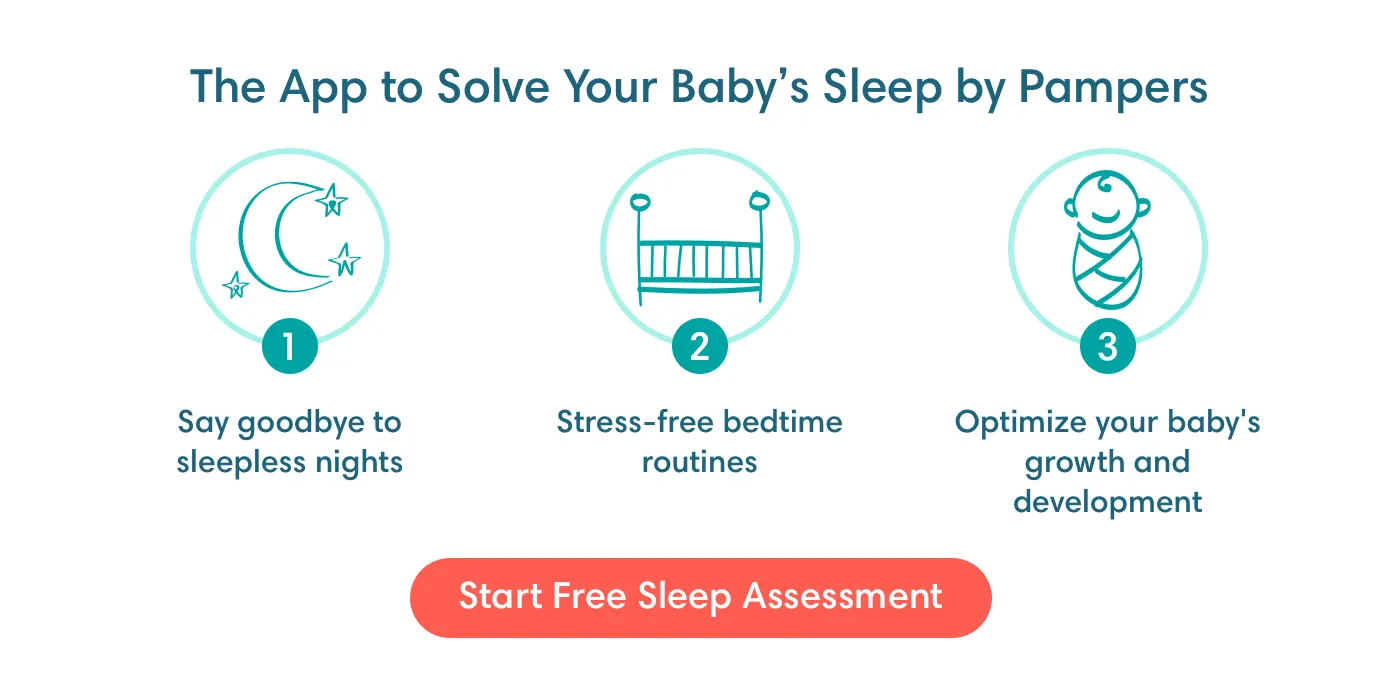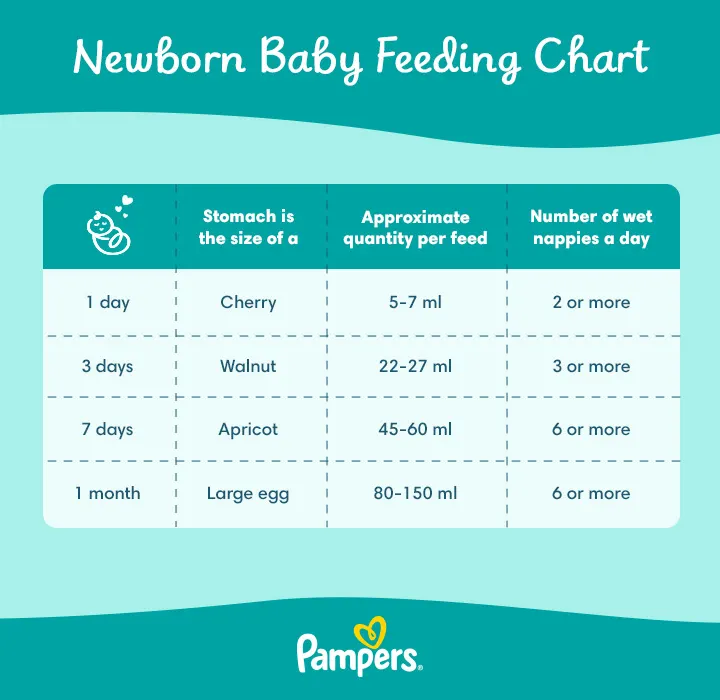All About Baby Feeding Schedules
If you’re wondering what’s a good feeding schedule for your newborn or older baby, you’re not alone – uncertainty about how much breastmilk or formula your baby needs is a common source of anxiety, especially if you’re a first-time parent. The good news is there are plenty of ways you can tell if your little one is getting enough nutrition. Read on to learn more and see our handy newborn feeding chart.
Newborn Feeding Schedule and Chart
Your baby will start growing surprisingly quickly right from birth, and all that growth needs to be fuelled by nutritious breastmilk or formula, and for the first few days and weeks you’ll be feeding your little one very frequently, maybe even once an hour.
The reason of this is simple. For the first day or two, your baby’s stomach is still about the size of a cherry, so it only holds about 5-7 millilitres – around 1 teaspoon – at each feed. Luckily, your very first breastmilk, a thick yellowy substance known as colostrum, is packed full of nutrients so even small amounts of it go a long way.
In fact, colostrum doesn’t just provide nutrition. It offers other health benefits from boosting blood sugar control, protecting against illnesses and allergies to helping with your baby’s first bowel movements. This is why, even if you plan to feed your baby with formula, experts recommend expressing colostrum in the last week or two of pregnancy, to give to your newborn baby.
What Is a Good Newborn Feeding Schedule?
No two babies are the same, and this is also true when it comes to how often to feed your newborn. As a very rough guide, in the first few weeks your baby will need to be fed at least 8-12 times every 24 hours, but experts advise feeding your baby ‘on demand’ rather than trying to make them eat a specific amount every day.
This means learning to recognise your baby’s hunger cues, such as:
Restlessness
Sucking on a fist or fingers
Murmuring
Rooting (turning their head and opening their mouth).
It’s best to start feeding your newborn as soon as you notice these early cues, as it’s harder to feed your baby once they start crying.
If your baby gets their nutrition from formula milk, it’s still recommended to watch for hunger cues and feed on demand. Your newborn is likely to eat small amounts, and frequently. If your little one doesn’t finish a bottle it’s ok – just be sure to make up a fresh bottle of formula for the next feed.
Is my Baby Getting the Right Amount of Milk?
Know that it’s impossible to overfeed a breastfed baby. This means it’s fine to breastfeed to relieve pressure when your breasts are feeling overly full, or just when you (or your little one) could do with a cuddle.
For formula-fed babies, a very approximate guide is that they will need 150-200 ml of formula per kilo of body weight every day until around the age of 6 months old, when you can gradually start to introduce solid foods. However, the rate of feeds can vary day-to-day so it’s still best to follow hunger cues and feed on demand.
Whether you feed your baby with breastmilk or formula, the best way to tell if your little one is getting enough to eat is by keeping track of wet and pooey nappies. As a rough guide, after the first week or so babies who are getting enough milk will produce at least around six wet nappies a day.
Another sign that your baby is getting enough nutrition is healthy weight gain. Your health visitor will be tracking your baby’s growth using baby weight and growth charts at your regular health and development reviews, but you can talk to your health visitor or doctor anytime if you have any concerns or questions about your baby’s growth.
Newborn Baby Feeding Charts
In the first days and weeks the amount your baby’s stomach grows quickly, and so does the amount they can eat, the length of time your baby sleeps between feeds – and the number of wet nappies you’ll be changing. Here’s a chart showing how your feeding schedule for a breastfed newborn baby could develop in the first month.
Babies who get their nourishment from formula may feed less frequently than breastfed infants, but all babies are different. Experts still advise feeding on demand based on your little one’s hunger cues and using your child’s wet nappies and healthy growth as an indicator of good nourishment. However, as a rough guide, during the first six months your baby could be eating the quantities in the chart below.
| Approximate quantities of formula milk in the first 6 months | ||
|---|---|---|
| Age | Feeds per day | Daily quantity |
| 0-2 weeks | 7-8 | 420-735 ml |
| 2-8 weeks | 6-7 | 450-735 ml |
| 2-3 months | 5-6 | 525-1,080 ml |
| 3-5 months | 5 | 900-1,050 ml |
| 6 months | 4 | 840-960 ml |
Keep in Mind
If you’re breastfeeding, make sure your little one latches on properly. This can be difficult when you’re starting out, especially for first-time mums, but over time your baby may begin to latch comfortably.
Ask your midwife or health visitor for advice if you’re having trouble getting a good latch, especially if you experience sore nipples or breast pain.
Your baby may feed more frequently during growth spurts, especially in the first 3 to 4 months. This is sometimes known as cluster feeding.
Alternate between breasts during each feed.
Look for signs that your baby is full, such as turning away from the breast, letting the bottle fall out of the mouth, feeding at a slower rate or losing interest. Once your baby seems full, stop feeding.
If you’re breastfeeding, your midwife, doctor or health visitor may recommend adding vitamin D supplements to your and your baby’s diet.
Video: Baby Feeding Tips
3-Month-Old Feeding Schedule
Now you and your little one have settled into a routine it might seem difficult to make changes, but as your baby grows you’ll need to adjust to their changing needs.
At 3 months, your baby is becoming more active, will begin to breastfeed less often, and may sleep for longer stretches at night. This in turn means fewer (but bigger) feeds in every 24-hour period.
If your health visitor sees that your baby is gaining weight and growing at a regular pace, then your child is probably getting the right amount of nutrition. Keep an eye on those wet nappies too! Your baby should be producing about six of these a day on average.
Check in with your health visitor or doctor if you’re concerned that your little one may not be getting enough to eat.
6-Month-Old Feeding Schedule
The half-year mark is when experts recommend starting to introduce solids to your baby’s diet, alongside the breastmilk or formula that still gives your child most of the energy and nutrients they need.
Keep in mind that solids are only a supplement at this stage, and that breast milk or formula is still your baby’s most important source of nutrition. At this stage the goal is for your little one to get used to eating food, and to try lots of different flavours. Letting your baby try a variety of different foods alongside breast milk or formula is a great way of laying the foundations for healthier eating later in life.
Night-time feeds might not be needed any more at 6 months old, but every baby is unique. Speak to your health visitor or doctor about whether it’s time to cut down on night-time feeds and what you can do to encourage the process.
Top Tip
|
7 to 9-Month-Old Feeding Schedule
Months seven through nine can be a good time to add a greater variety and quantity of solid foods to your baby’s diet. During this period you can gradually start to introduce three meals a day – breakfast, lunch and a mid-afternoon meal – alongside feeds as and when your baby needs them.
It’s important to include a wide variety of the main food groups in your baby’s diet. This means a healthy mix of:
Vegetables
Fruit
Starchy foods like pasta or potatoes
Protein foods such as meat, fish, eggs, beans and pulses
Pasteurised dairy foods, including full-fat yoghurt and cheese.
Now your baby’s getting into the swing of eating, you can introduce more and more new textures. A variety of purees, lumpier mashed foods and finger foods will help to broaden your little one’s culinary horizons. Keep in mind that babies need a bit of time to get used to lumps and finger foods, but practice makes perfect so keep offering different textures and stay close to make sure your child is swallowing safely.
10 to 12-Month-Old Feeding Schedule
Exploring new textures may now be a big part of your child’s meals. Your baby may be able to self-feed with finger foods such as chopped up bananas or pieces of pasta.
Breast milk or formula will still be an important part of your baby’s nutrition and energy intake and should continue to be their main drink for the first 12 months.
If you’re breastfeeding, continue to feed on demand and your baby will adapt their intake depending on how much solid food they’re eating. The same applies to formula-fed babies. As a very rough guide your child may need around 400 millilitres of first infant formula a day at this stage of weaning.
1-Year-Old Feeding Schedule
Now that you’re celebrating your baby’s first birthday, it’s also time to celebrate some of those feeding accomplishments. Your baby’s feeding schedule should include three meals a day, and maybe two healthy weaning snacks (like fruit, vegetables sticks, toast soldiers or plain, full-fat yoghurt).
This is also when to add cow’s milk to your baby’s diet, as an important source of calcium, energy and vitamin A (which is needed for healthy bones and teeth). Keep in mind that for now your toddler needs full-fat milk and dairy products. Skimmed or 1% fat milk doesn’t provide all the energy your child needs. Check with your health visitor or doctor if you have any questions about how and when to introduce cow's milk.
Sometimes children can be picky, so it’s not always easy to follow a strict feeding schedule, but as a general rule make sure your child eats on average, at least:
4 servings a day of starchy food like rice, bread and potatoes
4 servings a day of fruit and veg
350 ml of milk or 2 servings of dairy foods (or dairy alternatives)
1 serving a day of animal-sourced protein OR 2 servings of protein from vegetable sources (such as dahl, beans, chickpeas or other pulses).
Keep in mind that you still don’t need to add salt or sugar to your baby’s food. Too much salt can be bad for little kidneys, and sugar can lead to tooth decay.
You can continue to breastfeed your baby if you wish. Toddlers can find breastfeeding comforting, especially when they’re ill or upset, and many parents continue to breastfeed into the second year and beyond – it all depends on what you feel is right for you and your baby. Talk to your health visitor or doctor if you have questions about weaning.
FAQS AT A GLANCE
In the first few weeks your baby will need to be fed at least 8-12 times every 24 hours but experts advise feeding your baby ‘on demand’ by paying attention to hunger cues such as:
- Restlessness
- Sucking on a fist or fingers
- Murmuring
- Rooting (turning their head and opening their mouth).
Start feeding newborn sooner rather than later when you notice these early cues, as a crying baby is harder to feed.
The Bottom Line
As your baby grows and develops, their appetite and needs will change. Recognising your little one’s hunger cues, and the signs that they’re full, will help you take these changes in your stride and ensure that your little one is always getting the right amount of nutrition. When you introduce solids, offering a variety of textures and flavour can be the key to lifelong healthy eating.
Keeping track of wet and pooey nappies, as well as your child’s growth, will give you extra reassurance that your baby’s eating well, and of course your health visitor and doctor are always there to offer personalised help and guidance. Knowing that your baby’s feeding schedule is on track will give you extra freedom to all the other milestones ahead!
How we wrote this article The information in this article is based on the expert advice found in trusted medical and government sources, such as the National Health Service (NHS). The content on this page should not replace professional medical advice. Always consult medical professionals for full diagnosis and treatment.






